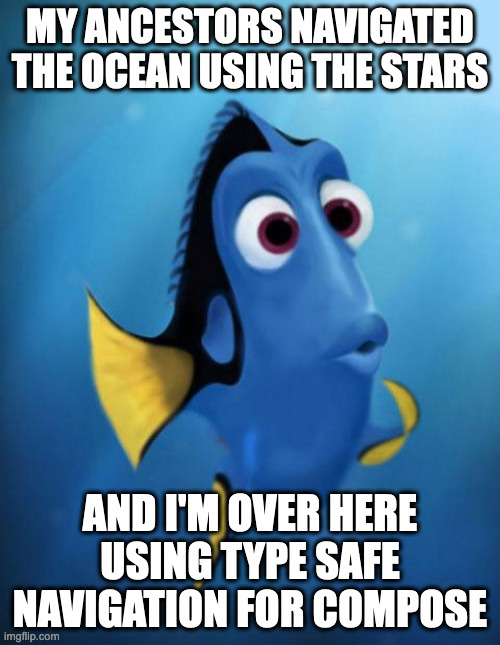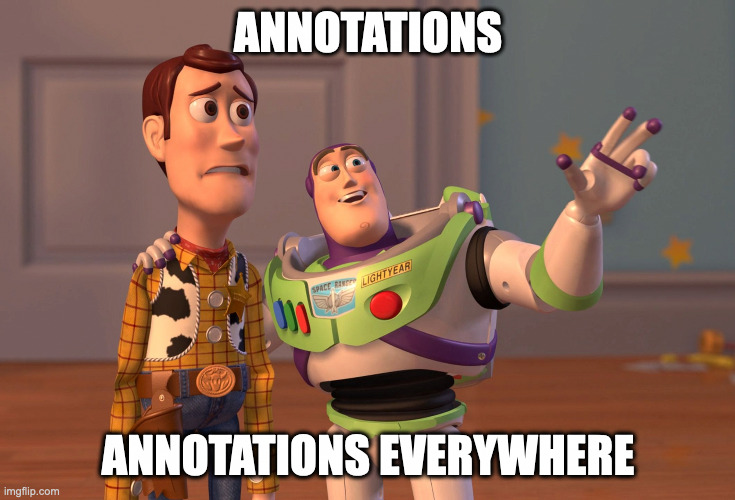Oh no, another type safe Compose Navigation library for Android
Intro
We live in a society where another day brings out the most necessary thing for an Android developer, another Navigation library.
But this isn’t one, or it kinda is, but with a twist, a type safe abstraction over the Android Navigation Component for Compose.
The opinions in this article are mine and reflect my experience, as every article is opinionated, so is this one.
Why?
I was searching for something that will suit my needs and scale based on the size of the projects I do, which sometimes consist of more than 50 screens with lots of dialogs, bottom sheet elements that consume all kind of arguments, none of the solutions really scaled well without forcing me to do weird things to just connect my routes, except for the official Android Navigation library for Compose by Google, no matter how many i’ve tried like Appyx, Decompose the only one that came close to the scalability was Voyager which I use for multi platform projects, really nice job guys.
I hope the Navigation controller by Google gets KMP support so that I can also adapt this library.
I came back to Google’s library, but it lacked type safety, so instead of complaining how incomplete it is, as a developer I found a “solution” to a problem I had, maybe you have it too.
Special thanks to compose-destinations as I borrowed the code for parsing the arguments from there.
Creating a type safe navigation
This isn’t just a stolen solution, it started from the bottom Part #1, Part #2, Part #3 and now we’re here.
To understand the structure and the idea, you can read Part #1.
Intro again
Shortly, every NavHost has a root Graph and additional Graphs, every Graph has a name/route, also it has a starting Destination and additional destinations where a Destination can be one either a: screen, dialog or bottom sheet, every Destination has a name/route, arguments, deep links and callback arguments from that destination.
- screen - can have animations: enter/exit, pop-(enter/exit) transitions, has an AnimatedContentScope when added to the
NavHost. - dialog - has properties when added to the
NavHost. - bottom sheet - has a ColumnScope when added to the
NavHost.
And each Destination renders UI, but we’ll decouple that from the navigation code for a good reason, it’s important to note that the part that’s gonna be responsbile for rendering the UI will be called Content, you can host your UI logic inside a Content object that will implement the generated destination.
Setup
Let me shamelessly introduce you my library for type safe navigation, foSho.
It’s called foSho which translates for sure, anyways, let’s write some code.
Just know that every part of the Navigation code we’ll write will have internal visiblity modifier as a requirement, no matter if it’s single module or multi module.
It’s based on KSP’s plugin to generate code with the help of KotlinPoet by Square.
The library is available through JitPack.
- Add JitPack to your project’s settings.gradle
1
2
3
4
5
6
7
8
dependencyResolutionManagement {
..
repositories {
..
maven {
setUrl("https://jitpack.io")
}
}
- Add the dependency in the build.gradle
1
2
3
4
5
6
7
8
9
10
[versions]
foSho = <version>
ksp = <version>
[libraries]
foSho-android = { module = "com.github.FunkyMuse.foSho:navigator-android", version.ref = "foSho" }
foSho-codegen = { module = "com.github.FunkyMuse.foSho:navigator-codegen", version.ref = "foSho" }
[plugins]
ksp = { id = "com.google.devtools.ksp", version.ref = "ksp" }
Inside the project build.gradle make sure to add the KSP plugin
1
2
3
4
plugins {
..
alias(libs.plugins.ksp).apply(false)
}
Inside the :app module
1
2
3
4
plugins {
..
alias(libs.plugins.ksp)
}
1
2
3
4
dependencies {
implementation(libs.foSho.android)
ksp(libs.foSho.codegen)
}
If you don’t have “feature” modules and you don’t plan to have your “screens”/”navigation” outside the :app module, inside the :app module make sure to add the KSP argument, the library is multi module by default.
1
2
3
ksp {
arg("foSho.singleModule", "true")
}
If you intend to use Hilt/Dagger/Anvil with foSho and want your generated ViewModel arguments injectable, inside :app module set foSho.injectViewModelArguments to “true”, default is “false”
1
2
3
ksp {
arg("foSho.injectViewModelArguments", "true")
}
this will generate inectable ViewModel arguments by adding the @Inject to the constructor, the argument is false by default
1
2
3
4
class MyViewModelArguments @Inject constructor(
override val savedStateHandle: SavedStateHandle
)
that you can easily inject them ex. using Hilt
1
2
3
4
@HiltViewModel
class MyViewModel @Inject constructor(
private val myViewModelArguments: MyViewModelArguments
) : ViewModel()
Single module
For single module everything that’s navigation logic and UI is going to be in the :app module and by now you have added the required argument
1
2
3
ksp {
arg("foSho.singleModule", "true")
}
Let’s explore a scenario for a Home graph that is a top level destination and also a starting graph.
In code this will look like this
HomeGraph.kt
1
2
3
4
5
6
7
8
9
10
11
12
13
14
15
16
17
18
19
20
21
22
23
24
25
26
27
@Graph(
startingDestination = Home::class,
destinations = [HomeDetails::class],
rootGraph = true
)
internal object HomeGraph
@Destination
@Argument(
name = "hideBottomNav",
argumentType = ArgumentType.BOOLEAN,
defaultValue = DefaultBooleanValueFalse::class
)
internal object Home : Screen
@Destination(generateViewModelArguments = true, generateScreenEntryArguments = false)
@Argument(name = "cardId", argumentType = ArgumentType.INT)
@CallbackArgument(name = "clickedShare", argumentType = ArgumentType.BOOLEAN)
internal object HomeDetails : Screen {
override val deepLinksList: List<DeepLinkContract>
get() = listOf(
DeepLinkContract(
action = Intent.ACTION_VIEW,
uriPattern = "custom:url/{cardId}"
)
)
}
HomeContent.kt
1
2
3
4
5
6
7
8
9
10
11
12
13
14
15
16
17
18
@Content
internal object HomeContent : HomeDestination {
@Composable
override fun AnimatedContentScope.Content() {
val argumentsFromHomeDetailsDestination = HomeDetailsCallbackArguments.rememberHomeDetailsCallbackArguments()
argumentsFromHomeDetailsDestination.OnSingleBooleanCallbackArgument(
key = HomeDetailsCallbackArguments.CLICKED_SHARE,
onValue = {
if (it == true) {
//user has clicked share
}
}
)
HomeScreen(onClick = {
Navigator.navigateSingleTop(HomeDetailsDestination.openHomeDetails(cardId = 42))
})
}
}
HomeDetailsContent.kt
1
2
3
4
5
6
7
@Content
internal object HomeDetailsContent : HomeDetailsDestination {
@Composable
override fun AnimatedContentScope.Content() {
}
}
The library is constructed to have a nested navigation by default, meaning that even for one destination, you will need to create a Graph, which is a good practice IMO.
When you annotate your graph with @Graph you must provide
- startingDestination: that is your
@Destinationwith one of the interfacesScreen,Dialog,BottomSheet - destinations: just as your
startingDestination, these are the other ones that are part of the graph - rootGraph: is
falseby default, but we must have onerootGraph
You must note that it’s not a good practice to replace the rootGraph, because by doing so when you pop the backstack the navigation component won’t know how to do that because it has been changed, this is a common scenario with Login situations, your Home screen should be the starting point, you will then check if the user is logged in or not, you will render the UI on the Home screen only if the user is logged in, otherwise you will redirect to the Login screen and start the flow.
Every @Destination that you have created with one of the interfaces Screen, Dialog, BottomSheet can additionally be annotated with an @Argument which are the type safe arguments generated for that destination, as well as @CallbackArgument which are the type safe callback arguments generated from that destination.
Every @Destination doesn’t generate type safe arguments by default but you can control that i.e @Destination(generateViewModelArguments = true, generateScreenEntryArguments = true).
The @Argument and @CallbackArgument have: name, type, whether the argument is nullable and a default value for which you must implement the ArgumentValue interface, there are some pre-defined commonly used ones as DefaultBooleanValueFalse etc…
Whem you click build, the type safe arguments will be generated:
HomeViewModelArguments, if"foSho.injectViewModelArguments"ksp arg is set to true these will be injectable otherwise you will have to provide theSavedStateHandlemanually as a parameterHomeNavArgumentsand a helper functionrememberHomeNavArgumentsthat you can use to obtain the type safe arguments in theContent.
When you add arguments to a destination for example HomeDetails, it generates an open function, indicating that you can open that destination with the argument, for example in our case HomeDetailsDestination.openHomeDetails(cardId = //provide int value) can be used to navigate to our details screen by calling Navigator.navigateSingleTop(HomeDetailsDestination.openHomeDetails(cardId = 42)).
When you add callback arguments to a destination for example HomeDetails it generates HomeDetailsCallbackArguments by appending CallbackArguments to the class you annotated, also there’s a composable function created to obtain these callback arguments HomeDetailsCallbackArguments.rememberHomeDetailsCallbackArguments() it follows the convention of rememberHomeDetailsCallbackArguments it appends the generated class name for the callback arguments, do note that each callback argument must be consumed for example you can obtain the argument clickedShare it’s generated for you but also you have a function called consumeClickedShare generated for you as well, after you use the argument, it’s better to consume it otherwise it’s gonna be there on config change and process death but if that’s your use case then don’t consume it.
Or you can use helpers functions which do that for you like HomeDetailsCallbackArguments.rememberHomeDetailsCallbackArguments().OnSingleCallbackArgument<String> that consumes the argument when its value is not null, some commonly used are there as well like OnSingleBooleanCallbackArgument, OnSingleStringCallbackArgument etc..
You can also have the deep links by implementing the list, I decided that it’s just a plain listOf so that we don’t clutter the annotations, but it may be just an annotation in the future as well?
1
2
3
4
5
6
7
override val deepLinksList: List<DeepLinkContract>
get() = listOf(
DeepLinkContract(
action = Intent.ACTION_VIEW,
uriPattern = "custom:url/{cardId}"
)
)
Every building block follows the same structure as the Android Navigation Component for Compose by Google.
When you build the project or (./gradlew kspDebugKotlin) for the defined destination Home you get a generated HomeDestination, meaning Destination suffix is added to your code and you will implement that destination for your @Content.
There’s only one function you will need to override and there you can host your logic and the UI for it.
For the HomeGraph the suffix NavigationGraph is added, meaning you get HomeNavigationGraph generated for you, all of that is aggregated in the GraphFactory.
After that you can hook up everything using the extension function addGraphs inside your NavHost.
If you decide to use the arguments inside the Content you must add CompositionLocalProvider(LocalNavHostController provides navController) once your rememberNavController is available, you can check the single module sample.
Finally you can add the NavHostControllerEvents to finish hooking up everything
1
2
3
4
NavHostControllerEvents(
navigator = Navigator,
navController = navController,
)
You use the Navigator to dispatch commands as well as consume those commands.
You can check out the sample for a single module integration.
Multi module
The multi module code follows the same principle, you don’t need to add any KSP arguments but there’s a way to structure your navigation code so that it’s available globally.
To achieve a global navigation you have to create an umbrella module, you can call it navigator or however you see fit where you would write the code for the Graphs.
:navigatormodule;UserAccountGraph.kt
1
2
3
4
5
6
7
8
9
10
11
12
13
14
15
16
17
18
19
20
21
22
23
24
@Graph(
startingDestination = UserAccountDetails::class,
destinations = [
EditAccountDetails::class,
DeleteAccount::class,
ChangePassword::class,
]
)
internal object UserAccountGraph
@Destination
internal object UserAccountDetails : Screen
@Destination
internal object ChangePassword : BottomSheet
@Destination
internal object DeleteAccount : Dialog
@Destination(generateScreenEntryArguments = true)
@Argument(name = "email", argumentType = ArgumentType.STRING)
@CallbackArgument(name = "isAccountUpdated", argumentType = ArgumentType.BOOLEAN)
internal object EditAccountDetails : Screen
:navigatormodule;HomeGraph.kt
1
2
3
4
5
6
@Graph(startingDestination = Home::class, rootGraph = true)
internal object HomeGraph
@Destination
@Argument(name = "hideBottomNav", argumentType = ArgumentType.BOOLEAN, defaultValue = DefaultBooleanValueFalse::class)
internal object Home : Screen
Your :navigator module acts as the only point where you have the navigation code and nothing else, here you can control the arg whether to generate injectable view model arguments through
1
2
3
ksp {
arg("foSho.injectViewModelArguments", "true")
}
Then inside your feature modules you will add the :navigator module
:feature:user_details:UserAccountDetailsContent.kt
1
2
3
4
5
6
7
@Content
internal object UserAccountDetailsContent : UserAccountDetailsDestination {
@Composable
override fun AnimatedContentScope.Content() {
}
}
and also make sure to add the :feature:user_details and :navigator in your :app module so that it will aggregate everything for you into the GraphFactory.
Until next time
At the moment of writing of this article I don’t have a multi module sample project, but I am in the process of making one very soon and will update the Github repo with a link to it and this article. I hope the aforementioned code is enough for you to use the library in a multi module environment.
Thank you for your wholehearted attention, I hope that this library will help you scale your projects like it did help me, I decided to share this library as I had it created for my personal projects.


